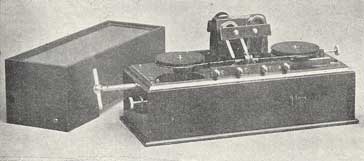Magnetic Detector
Details of the magnetic detector, sometimes referred to as the Marconi Magnetic Detector used in very early radio or wireless receiver sets before other forms of detector were available.
Magnetic Detector History Includes:
Magnetic detector
Operation & construction
The magnetic detector was an early form of radio detector used during the early 1900s.
The magnetic detector, or "Maggie" was found to be more reliable than the coherer, an earlier for of detector for wireless signals.
Although Marconi did not invent the magnetic detector, he did a considerable amount to develop it and as a result, it was sometimes referred to as the Marconi Magnetic Detector.
Although the magnetic detector was later superseded by more sensitive forms of wireless or radio detector, the Maggie, provided useful service while it was in use.

Magnetic detector invention
The effects on which the magnetic detector is based had been observed as early as 1842.
At this time Joseph Henry had been investigating the effects of electromagnetism and he discovered that magnetised needles became demagnetised when they were in the vicinity of a discharging Leyden jar.
Then in 1895 Ernest Rutherford took this idea forwards and used the concept to detect radio waves, or as they were referred to at this time, Hertzian waves. He managed to achieve signal detection using this process at a distance of just under a mile at the Cavendish Laboratory in Cambridge, UK.
The ideas used by Rutherford were further developed by Professor Ernest Wilson in 1897.
Later, realising the limitations of the coherer, especially thinking of setting new records for distance, Marconi realised the need for any improvements in receiver sensitivity. As the coherer was notoriously insensitive, he invested considerable effort into developing the magnetic detector which had distinct advantages and possibilities for further development. He patented his ideas improvements for the magnetic detector in 1902.
Rather than using a sounder which sounded when the coherer cohered, the magnetic detector used headphones in which the operator could actually hear the signal.
Much of the work in optimizing and developing the concept for the Marconi magnetic detector was undertaken at the Chelmsford base of the Marconi company. Little was understood about the science and technology behind the magnetic detector, so much of the work was trial and error.
That said, the magnetic detector represented a major improvement in detector reliability. As a result, it was widely used in ships and became affectionately known as a Maggie.
Marconi started to replace the detectors on ships through 1903, thereby considerably improving the performance of the systems he had installed and he gained an edge over his competitors.

View from top
Magnetic detector use
After the invention of the magnetic detector its use became widespread. It was more sensitive and reliable than the coherer and it enabled signals to be directly heard in headphones.
The magnetic detector was more sensitive and also more reliable than the coherer. As a result, it was widely used as the standard detector on maritime receivers between about 1902 until about 1914. They were particularly suited to use on board ships where they were relatively immune to their movements, unlike coherers which were not.
After this time it tended to be replaced by crystal and valve or vacuum tube detectors that were more sensitive.
Marconi made considerable use of the magnetic detectors using them for his famous first transatlantic wireless transmission in 1901.
Magnetic detector advantages
The magnetic detector had a number of advantages over the previous coherer detector used:
- Improved sensitivity: the coherer had been notoriously insensitive – it needed sufficient signal to cause the filings in the coherer to cohere. The magnetic detector managed to provide a significant improvement, and the signals were actually heard in headphones. That said the magnetic detector was not as sensitive as later forms of detector.
- Improved reliability: The coherer was not always particularly reliable. The man=gnetic detector managed to provide a significant improvement, and it was quite insensitive to movement making it very suitable for use on board ships.
- Improved performance in presence of interference: Interference was a particular issue because the coherer would respond to any impulse. As headphones were used with the magnetic detector and the signal itself heard, it was possible for the operator to distinguish between the signal and interference.
- Improved reception speed: The coherer had a limited speed of operation - it needed to be decohered before another signal could be detected. The magnetic detector had no such limitation. It was therefore possible to considerably increase the speed of transmission when using a magnetic detector.
Magnetic detectors were relatively complicated to manufacture and this made them expensive. As a result they were often outside the reach of amateur experimenters.
 Written by Ian Poole .
Written by Ian Poole .
Experienced electronics engineer and author.
More History:
Radio history timeline
History of the radio
Ham radio history
Coherer
Crystal radio
Magnetic detector
Spark transmitter
Morse telegraph
Valve / tube history
PN junction diode invention
Transistor
Integrated circuit
Quartz crystals
Classic radios
Mobile telecoms history
Vintage mobile phones
Return to History menu . . .



